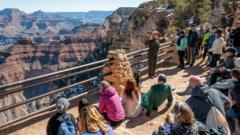The recent decision by the Trump administration to drastically cut staff at national parks and forests has led to increasing frustrations from both visitors and conservation workers. This is anticipated to have long-lasting impacts on public safety and the environment.**
National Parks Face Crisis as Staffing Cuts Spark Public Outcry**

National Parks Face Crisis as Staffing Cuts Spark Public Outcry**
Deep staffing cuts at national parks and forests in the U.S. have ignited intense backlash, challenging public access, safety, and conservation efforts.**
The Trump administration's significant staffing reductions in the United States' national parks, forests, and wildlife habitats have prompted widespread outrage as the quality of public access and conservation efforts deteriorate. The changes have already adversely affected visitors, who now encounter longer entry lines, restricted visitor centre hours, closures of popular trails, and poorly maintained facilities.
Kate White, a dedicated ranger in the Enchantments, an alpine wilderness in Washington state, notes that her team would typically clear away 600 lbs of litter from the area. With staff cuts, the risk of overflowing backcountry toilets increases, potentially harming the local ecosystem. "I'm not sure how this will be maintained," she explains. Additionally, as a ranger for nearly a decade, she has prioritized keeping visitors safe in precarious environments, a role that now hangs in the balance due to these budget cuts.
The reductions, which began on February 14, have impacted approximately 5% of the National Park Service workforce—over 1,000 employees—along with around 10% of the US Forest Service's staff, which translates to around 3,400 jobs lost, including hers. Notably, visitor numbers are staggering; national parks attract about 325 million visitors annually, and national forests, about 159 million, placing immense importance on staffing the facilities adequately.
The ramifications of these cuts were starkly evident during the recent President's Day weekend when long lines formed at the Grand Canyon due to a shortage of toll operators. Trail closures followed shortly after the cuts, highlighting immediate implications directly tied to the staffing shortfalls. Protest actions, including the display of an upside-down American flag at Yosemite's "firefall," have drawn public attention to the concerning staffing situation.
Andria Townsend, a former carnivore biologist at Yosemite, voiced her deep concern for endangered species under her care, citing the uncertain future of the Sierra Nevada red fox and its related species, as the personnel needed to ensure their protection have now vanished.
Staff members Claire Thompson and Xander Demetrios, who lost their jobs after years of dedicated service, expressed dismay at being dismissed for "performance" issues, emphasizing their commitment to keeping the trails safe for hikers. Thompson noted, “It feels like our work is devalued by those who clearly do not understand our roles.”
In the wake of public pushback, some national park employees have reportedly been reinstated, and plans are underway to hire over 5,000 seasonal workers to fill gaps as the busy tourist season approaches. However, Interior Secretary Doug Burgum remains focused on reducing the national deficit, suggesting the rationale behind these cuts outweighs their immediate impacts.
Visitors heading to national parks might have to temper their expectations, as signs of reduced services and maintenance are already appearing. Parks including Yosemite have lost essential personnel, impacting everything from cabin reservations to trail repair efforts. There are also heightened concerns regarding the safety of summer firefighting efforts, pointing to a troubling resource gap that could amplify risks during wildfire season.
As this situation unfolds, advocates warn that the long-term effects of staffing cuts could jeopardize the very essence of the natural landscapes that millions of Americans seek for recreation and restoration each year.





















